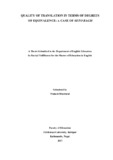Please use this identifier to cite or link to this item:
https://elibrary.tucl.edu.np/handle/123456789/1524| Title: | Quality of Translation In Terms Of Degrees Of Equivalence |
| Authors: | Bhattarai, Prakash |
| Keywords: | Nepali Literature;Nepali Novel;Transation;Teaching methods |
| Issue Date: | 2017 |
| Publisher: | Faculty of Education Tribhuvan University, Kirtipur Kathmandu, Nepal |
| Abstract: | This present research study entitled „Quality of Translation in Terms of Degrees of Equivalence: A Case of Seto Bagh was conducted to investigate the degrees of equivalence between two versions, their frequency and the techniques of translation and contribution of technique/s in optimum degree of equivalence. Both versions of the novel were used as the sources of data. Under survey design, interpretative and analytical procedures along with qualitative data were used. Fifty cultural terms were randomly selected from the novel named „The Wake of The White Tiger‟ and Seto Bagh and analyzed them under various techniques according to the meaning conveyed by them. The researcher categorized, analyzed and interpreted the data with the help of Ekta Comprehensive Nep- Eng Dictionary (1st ed.) and Oxford Advanced Learners‟ Dictionary (8th ed.). Among six degrees of equivalence, optimum degree of equivalence was the most frequent one which covered forty eight percent where as partial, poor and zero were found as least frequent ones, It was found that in addition to literal translation, sense translation, definition, substitution and transliteration were commonly employed techniques of translation . The thesis has been divided in to five chapters. First chapter entitled Introduction‟ includes background of the study, statement of the problem, objectives of the study, research questions, significance of the study, delimitations of the study, and operational definitions of the key terms. Similarly, second chapter entitled „Review of Related Literature and Conceptual Framework‟ illustrates the major study of translation like: language, culture, religion, translation studies, their relationship, techniques, gaps including introduction of the book. The third chapter „Methods and Procedures of the Study‟ includes major elements of the study especially design and method of the study, population , sample and sampling strategy, research tools, sources of data(primary and secondary), data collection procedures, data analysis and interpretation procedures and ethical considerations. Fourth chapter „Analysis and Interpretations of the Results‟ is the central essence of the study as it analyzes the data and interprets of the results. Fifth chapter „Findings, Conclusion and Recommendations‟ summarizes the findings with main conclusion and provides some suggestions as per the findings derived and with special recommendations in level wise. |
| URI: | http://elibrary.tucl.edu.np/handle/123456789/1524 |
| Appears in Collections: | English Language Education |
Items in DSpace are protected by copyright, with all rights reserved, unless otherwise indicated.

